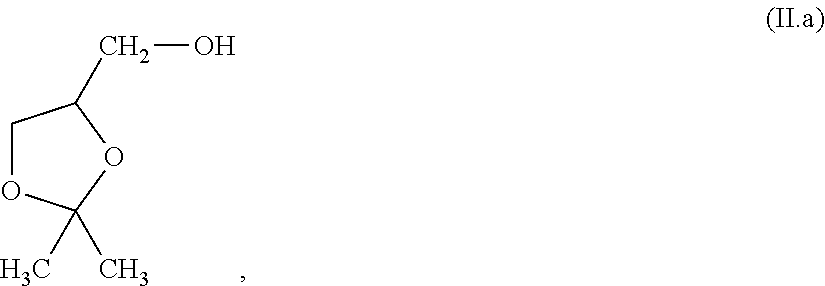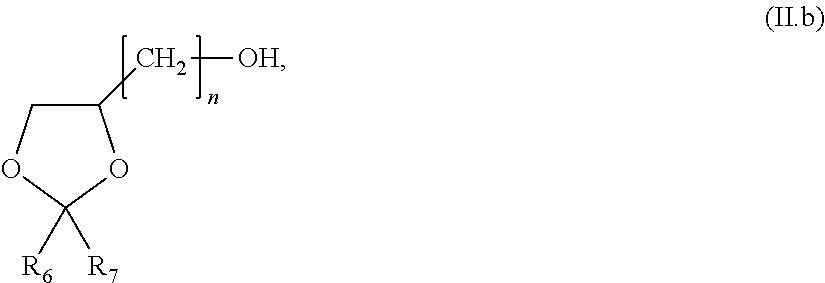Stabilized dcd and/or alkyl thiophosphoric triamide solvent systems and use in agricultural applications
a technology of dcd and/or alkyl thiophosphoric triamide, which is applied in the direction of application, group 5/15 element organic compounds, alkali orthophosphate fertilisers, etc., can solve the problems of ammonia loss to the atmosphere, not allowing binding, and a large amount of nitrogen applied, so as to slow the conversion of ammonium and slow the loss of ammonia , the effect of high water solubility
- Summary
- Abstract
- Description
- Claims
- Application Information
AI Technical Summary
Benefits of technology
Problems solved by technology
Method used
Image
Examples
experiment 1
[0176]2-Amino-2-methyl-1-propanol: Compositions were prepared by mixing components in the amounts indicated in Table 1. The amine stabilizer utilized was 2-Amino-2-methyl-1-propanol. Composition 1 was utilized as a comparative example, i.e., without added amine stabilizer.
TABLE 1Various Compositions with / without 2-Amino-2-methyl-1-propanolComposition 1Composition 2Composition 3Componentwt %wt %wt %NBPT525252DMSO4844382-Amino-2-methyl-1-0410propanolTotal100100100
TABLE 2Flash point of Compositions (2-Amino-2-methyl-1-propanol)NBPT + DMSO with2-Amino-2-methyl-Initial flash pointFlash point after 21-propanol (wt %)(° C.)weeks at 54° C. (° C.)096.552.0 4%92.190.310%89.389.2
[0177]Referring to Table 2, the flash point was measured for Composition 1 (control), Composition 2 and Composition 3 initially and 2 weeks thereafter. Without an amine stabilizer, the flash point of the NBPT composition (i.e., Composition 1) exhibited a dramatic drop from 96.5° C. to 52.0 after 2 weeks at 54° C. The s...
experiment 3
[0180]2-Amino-1-butanol: Compositions were prepared by mixing components in the amounts indicated in Table 5. The amine stabilizer utilized was 2-Amino-1-butanol. Composition 1b was utilized as a comparative example, i.e., without this added amine stabilizer.
TABLE 5Composition with / without 2-Amino-1-butanolComposition 1bComposition 2bCompositionComponentwt %wt %3b wt %NBPT525252DMSO4844382-Amino-1-butanol0410Total100100100
TABLE 6Flash point of Compositions with 2-Amino-1-butanolNBPT + DMSO with2-Amino-1-butanolInitial flash pointFlash point after 2(wt %)(° C.)weeks at 54° C. (° C.)096.552.0 4%94.191.510%93.292.6
[0181]Referring to Table 6, the flash point was measured for Composition 1b (control), Composition 2b and Composition 3b initially and 2 weeks thereafter. Without the 2-Amino-1-butanol amine stabilizer, the flash point of the control (Composition 1b) exhibited a dramatic drop from 96.5° C. to 52.0 after 2 weeks at 54° C. The solution was observed to undergo a color change fro...
experiment 4
[0182]Amine stabilizer for NBPT+DCD (2-Amino-2-methyl-1-propanol).
TABLE 7Composition of NBPT + DCD with 2-Amino-2-methyl-1-propanolComposition 1cComposition 2cComponentwt %wt %NBPT66DCD2424DMSO70682-Amino-2-methyl-1-propanol02Total100100
[0183]Summary of Observations:
[0184]The color of solution of the NBPT and DCD composition (Composition 1c) changes from colorless to amber after 2 weeks at 54° C. The color of solution of the NBPT and DCD composition does not change with the addition of 2% 2-Amino-2-methyl-1-propanol (Composition 2c) after 2 weeks at 54° C. This would appear to indicate that Composition 2c is more stable (degradation stability) over the same period of time versus the control.
PUM
| Property | Measurement | Unit |
|---|---|---|
| solubility | aaaaa | aaaaa |
| temperatures | aaaaa | aaaaa |
| temperatures | aaaaa | aaaaa |
Abstract
Description
Claims
Application Information
 Login to View More
Login to View More - R&D
- Intellectual Property
- Life Sciences
- Materials
- Tech Scout
- Unparalleled Data Quality
- Higher Quality Content
- 60% Fewer Hallucinations
Browse by: Latest US Patents, China's latest patents, Technical Efficacy Thesaurus, Application Domain, Technology Topic, Popular Technical Reports.
© 2025 PatSnap. All rights reserved.Legal|Privacy policy|Modern Slavery Act Transparency Statement|Sitemap|About US| Contact US: help@patsnap.com



